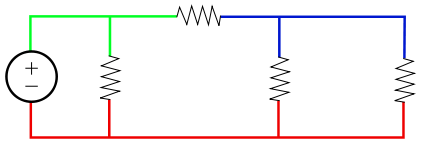Node (circuits)
In electrical engineering, a node is any point on a circuit where the terminals of two or more circuit elements meet. In circuit diagrams, connections are ideal wires with zero resistance, so a node may consist of the entire section of wire between elements, not just a single point.[1]

According to Ohm's law, V = IR, the voltage across any two points of a node with negligible resistance is
showing that the voltage at every point of a node is the same. However, there are some notable exceptions where the voltage difference is large enough to become significant:
- high-precision resistance measurements using a Kelvin connection
- the difference in voltage between ground and neutral, between the neutral wire and the safety ground in domestic AC power plugs and sockets, can be fatal. A properly installed electrical system connects them together at one (and only one) location, leading many people to the fatally incorrect conclusion that they are at "the same" voltage, or that the safety ground is "redundant and unnecessary."
- the Seebeck effect and the Peltier effect
- joints involving aluminium wire
Dots used to mark nodes on a circuit diagram are sometimes referred to as meatballs. [2]
References
This article is issued from
Wikipedia.
The text is licensed under Creative Commons - Attribution - Sharealike.
Additional terms may apply for the media files.